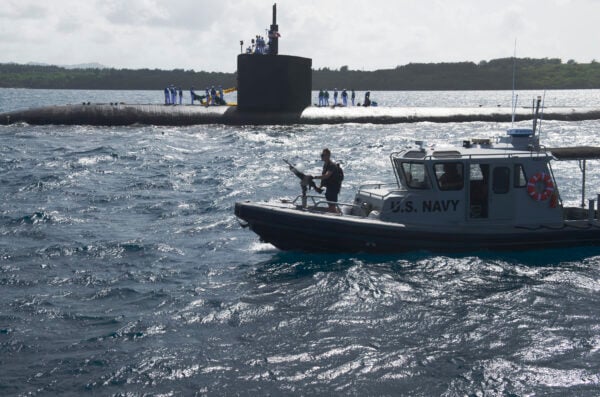
Chinese illegal migrants flood Guam amidst Beijing’s escalating efforts to challenge US military presence, prompting urgent calls from the island’s congressional representative for heightened island protection.
For most Americans, the island of Guam might evoke fleeting thoughts of beaches and military bases. However, this U.S. territory far exceeds its postcard image. With a population of 168,000 American citizens, Guam holds a pivotal role in the Indo-Pacific, serving as a crucial strategic center for the U.S. military.
Recently, the Chinese Communist Party (CCP) has intensified its pressure on the island, both militarily and through espionage. As an unincorporated U.S. Territory, Guam holds only non-voting representation in Congress. Now, Guam Representative James Moylan sounds the alarm, highlighting the recent surge of illegal Chinese migrants as just one facet of Beijing’s escalating threat against the island.
The island of Guam hosts two major U.S. military installations: Naval Base Guam (NBG) and Andersen Air Force Base (AAFB). NBG stands as the largest U.S. Navy base in the Pacific Ocean, encompassing key facilities such as Apra Harbor and ship repair yards, along with various tenant commands. With an estimated 9,670 active-duty military personnel, NBG plays a vital role in maritime operations.
Andersen Air Force Base (AAFB) serves as a crucial strategic airbase, supporting the U.S. Air Force, Navy, and Marine Corps. Featuring one of the longest runways in the Western Pacific, AAFB accommodates fighter squadrons, bombers, and support aircraft. AAFB hosts around 8,000 active-duty military personnel.
Beyond its regional security role, Guam has been instrumental in supporting U.S. military operations from the Korean War through to more recent conflicts like Afghanistan and the Middle East.
Beijing’s discontent with the U.S. military presence in the expansive Indo-Pacific, a region it seeks to dominate, is evident. In recent times, Chinese hackers targeted U.S. military installations in Guam.
Additionally, the People’s Liberation Army (PLA) routinely conducts simulated strikes on Guam using missiles and bomber aircraft. Concurrently, China has bolstered its naval footprint in the Indo-Pacific, with the People’s Liberation Army Rocket Force (PLARF) possessing missile capabilities capable of striking Guam, dubbing its DF-26 ballistic missile the “Guam Killer.”
Moreover, patrols by the People’s Liberation Army-Navy near Guam have surged in frequency, which Guam Representative Moylan calls an “overt provocation to the United States. In an interview with Fox News, he emphasized the pressing need for heightened U.S. military protection in light of the escalating Chinese military threat.
He said, “Right now, the communist Chinese party has warships just outside our boundary lines near Guam. Our main concern is the (military) buildup on Guam to protect the residents of Guam and to protect our nation, being the most forward deployed, strategically located United States property with U.S. citizens living there and the military bases being built there.”
In the U.S., conservatives are concerned about the influx of illegal immigrants, particularly through the Southern Border, where Chinese nationals represent the fastest-growing demographic.
This surge raises legitimate concerns about national security, especially considering the U.S. intelligence community’s identification of the People’s Republic of China (PRC) as the foremost espionage threat.
Furthermore, a Joint Cybersecurity Advisory, comprised of the U.S. National Security Agency and the Federal Bureau of Investigation (FBI), underscores the PRC’s primary threat to critical infrastructure, including electrical grids.
Against this backdrop, the Guam representative’s worries about Chinese migrants collaborating with the Chinese Communist Party (CCP) to undermine the island’s defense capabilities are justified.
Guam is facing dual threats from China: overt provocations by the PLA-Navy and the espionage/sabotage risk posed by Chinese illegal migrants.
Representative Moylan advocates for increased defense funding for Guam, prompting questions about Democrats’ priorities. While tens of billions of dollars are allocated to support Ukraine, they are failing to protect a strategic U.S. territory.
Furthermore, mainstream media reluctance to address the espionage and sabotage threat reflects a broader trend of avoiding discussions that could be deemed racist.
In today’s press climate, even hinting at the potential risks of admitting unvetted individuals from adversarial nations can lead to cancellation.
The mainstream media largely disregards the influx of Chinese illegals into Guam, while Democrat lawmakers prioritize the defense of Ukraine over that of Guam.
It’s no wonder that the Republican Party has emerged as the voice for U.S. territories. In 2022, Guam flipped Republican for the first time in 30 years, a notable shift considering its 13-point margin in favor of Biden in the 2020 polls.
Yet, it appears that critical issues such as national security, illegal immigration, and China are important enough to change people’s minds.



Post a Comment